Fly tying material is often big, inexpensive pieces cut up and sold small at high prices. It's always worth looking around for alternative sources. You can find some really useful materials for almost no money.
I recently dug into my box of pike fly materials to get out stuff for a few large, articulated flies. The main contents of this box is large pieces of craft fur, large bunches of different types of flash, different synthetic hairs and... wigs. Yes, wigs!
Wigs for pike
The box contains a small handful of wigs, actually. Not your blonde bimbo wig or wigs meant to look like human hair, but party wigs. Party wigs are, as the name implies, wigs meant to be worn to parties. Now, I rarely go to parties where the guests are expected to wear colorful wigs, but some people must obviously do so, because there's quite a market for these crazy wigs.
The party wigs are essentially fly tying to put on your head. Non-fly tyers may not see them as such, but it doesn't take many glances at some of these wigs for a fly tyer to realize that there's a colossal amount of useful material in most of them.
And they are usually very inexpensive. Prices in the range of a couple of dollars for simple flash wigs and maybe 5-10 US$ for wigs made with synthetic hair are quite common. And needless to say that you get ten times, twenty times or more, the amount of material you would get for the same price in a flyshop.
Sure, some of the materials appear to be useless once you get them in your hands – can't get wet without breaking or loosing color, fragile, too fuzzy or in some other way unsuited for flies. But that might be one out of five or ten. The rest are fine, and considering the price, that's a pretty good ratio.
In this article
Look around
My wig experience has taught me to look around for fly tying materials in other places than flyshops. It almost goes without saying that any hobby or craft store will potentially have a ton of stuff you can use, but sewing shops, yarn shops, office supply shops, gift shops, toy shops and many other outlets will potentially also have some fly tying gems on their shelves. And party shops with costumes and decorations are of course chuck full of fly tying.
In most cases the materials are basically similar to what you can find in flyshops, just larger packages for less money. In other cases they vary a bit. Often they are slightly more coarse than the flyshop equivalents, and if you tie dry flies, classic wet flies, streamers or some other sort of traditional flies you will most likely see less useful materials than if you tie for the salt, for bass fishing or pike fishing. Pike fly tiers in particular can expect to find a lot that can be used.
Places to look online
These are some of the places worth looking for alternatives to many common fly tying materials.
- eBay has a surprising number of sources for large quantities at low prices. Chinese manufacturers in particular have very low prices and surprisingly often send without adding postage expenses. If you're outside the US you can use your local eBay if it exists, or eBay.co.uk from many European countries.
- Amazon doesn't have quite as many sources for alternative materials useful for fly tying, but does have some useful stuff once you start peeking around.
- Alibaba is a large Chinese based marketplace where you can buy essentially any product coming out of China. But unlike eBay and Amazon Alibaba is a bit harder to use for private individuals and cater mainly to businesses and wholesalers. You can use AliExpress as an alternative. It's made for consumers, but has a smaller and - obviously - more consumer oriented selection, meaning smaller quantities and higher prices.
Ordering from many of the sellers in China, Hong Kong and other Asian countries can be a patience game. The transport time is usually weeks, sometimes months. I have had things arrive from China within a week, but mostly you will get your order after 2-3 weeks. If they don't come, just wait another 2-3 weeks and then return to the seller online. They will often resend your order at no cost. I have only had two orders completely disappear, and got a refund in one case and a replacement in the other. Buying locally - even online - usually means much faster delivery, but mail order is generally not for the impatient no matter where you order. If you need it now, then it's brick and mortar stores for you.
You can also look for craft, hobby and DIY jewellery stores, which are typically smaller and local, but still have a lot of interesting products. The same goes for party supply stores, but don't forget toy stores and even office supply stores.
You can also find some outlets that cater to fishermen, and have materials at very good prices. Places like:
Fly Tyers Dongeon - a shop specialized in inexpensive materials for large flies in particular.
Mudhole - a large supplier for rod and lure builders who also has wire, paint, glue and many other things useful for fly tyers.
J. Stockard Fly Fishing - has a lot of materials at very fair prices, although not extremely low.
Jann's Netcraft - Another store for DIY anglers with low prices and a large selection of fly tying materials.
The obvious sources
It goes without saying that almost any material that has the right attributes (thickness, color, mobility, buoyancy etc.) and can withstand being wet is a potential fly tying material. Condoms and rubber gloves comes to mind. Numerous really excellent nymph patterns have come from these common everyday items. Also consider heavy plastic bags, all kinds of packaging like thin protective foam, gift wrapping band, fabrics like organza and much more.
Christmas decorations can deliver an almost endless supply of flash and never leave a children's party without looking at the waste. A lot of party ornaments are made from what is essentially fly tying by the yard.
Wire and yarn bits are also widely available. Old fashioned electric current transformers - as found in many older electronic appliances - can contain a lifetime supply of copper wire for nymphs like Copper Johns and ribbing for larger flies.
But such materials are not the only ones. Many "brand name" materials sold specifically for fly tying, are actually just some cheap product, bought in bulk, cut into smaller pieces and sold at a premium to us fly tyers.
What's in a name?
If you start looking around for alternative sources for well known fly tying materials, you will often find that your search will lead to fly tying sources rather than alternative sources. That's because the fly tying community and the wholesalers often rename the products to a more fly tying related name.
Look at examples like Squirmy Wormy legs. The Squirmy Wormy has become synonymous with a fly made of a very soft, colorful, rubbery material. An online search for Squrimy Wormy leads to flies only, and add the word material and you will be lead to bags of bags twenty pieces sold at 3-4-5 USD. But look for the right name and magic happens. The price drops to a dollar for hundreds of pieces. See the chapter below for more details.
So part of the drill in finding alternative sources is to find the original name of the product. The non-fly tying name, so to say. In my list below, I include some of these names, so that you can do your own searches.
The following list is just a few examples of what I've found over the years.
...part of the drill in finding alternative sources is to find the original name of the product...
Synthetic hair
I already mentioned the wigs and craft fur is mentioned below, but there's much more synthetic hair out there, which can be used for flies. Such hair is particularly useful for people tying larger streamers and pike flies, but can certainly find its place in other patterns too.
The synthetic hair is often used by hair dressers, braided together with natural hair or used as extensions, and the places to look is in shops that cater to such crafts.
CyberloxShop has an incredible 136 colors of its Phantasia Kanekalon Jumbo Braid, which is hair meant to be used in hair dressing, but definitely useful for fly tyers too. The shop also has the more frizzy, sparkling Angelina Fibre. Many other types are available from many other sources once you start looking.
- synthetic braid fiber
- artificial braid fiber
- synthetic fiber hair
- artificial fiber hair
- artificial hair integrations
Dubbing
Dubbing is omnipresent. You can find material useful for dubbing in so many places. Inside soft toy animals, inside pillows, by teasing out yarn, by trimming synthetic fur – even by just emptying the filter in your clothes dryer if you use one.
Looking for dubbing online is more difficult since much of what we buy commercially is just available wholesale or when bought in flyshops. But of course if you don't mind buying half a pound at a time, the sources are there. But you will get dubbing for a dozen of lifetimes and will definitely need someone to share with. So called Angelina fiber is a shiny, slightly curly fiber available in a wealth of colors and in more humane quantities like 10, 25 or 50 grams at a time. But even 50 grams will give you an amazing amount of material.
Braided tube, body tubing
So called body tubing has been around for many years, and has been sold to fly tyers in small pieces at high prices. I have some pieces that are at least 20 years old, brand name stuff sold as Corsair and E-Z Body and bought expensively, even back then.
But last year I was in the US and went shopping in a small party shop. And there it was... body tubing. Here it was called Crinoline Tube, and I bought a length of black and a length of pearl. Each was a couple of dollars and I probably got about 30 feet of tube for less than 5 USD.
Once I had the magic word - crinoline - a door opened, and I could easily find non-fly tying supplies of this cheap material. Web searches soon revealed other names such as "poly mesh tube", "deco flex tube" or "Mylar tinsel tube", and armed with those names, finding alternative sources for this useful material wasn't hard.
For pike flies you will want the stuff that's at least 8-10 mm or 3/8 of an inch, and preferably thicker. Thinner tube can be used for baitfish while even thicker tube can be used for the largest pike and saltwater flies as well as for crab flies like the Ninja Toe Biter.
You can also find this kind of tube incorporated in party hats and wigs, where you can get some products with a whole wealth of different colors and sizes, ready for you to cut apart.
The color combinations are endless and you can find the most fantastic patterns with flash and different color threads weaved into intricate symmetrical designs.
- Crinoline tube
- Poly mesh tube
- Deco flex tube
- Mylar mesh tube
- Mylar tinsel tube
Also try replacing tube with tubing.
Here's a couple of examples from Etsy and some 8mm tube from eBay.
Cylindrical foam
Pieces of cylindrical f0am, often called Float Foam, is used for many types of flies, from beetles and ants over bass flies to caterpillars and even booby flies.
It's available for fly tying pre-cut into smaller pieces of less than an inch meant for hoppers, beetles, ants and such, or in longer pieces, like 20-25 inches. Common for these products is their price. They aren't cheap, let's just put it that way.
But there are alternatives, namely sponge cord.
Sponge cord is like an endless caterpillar. It's originally used for sealing and filling and can be bought in coils of thousands of feet for industrial and construction use.
Now, thousands of feet might be overdoing it a bit if you just need it for fly tying, but the material is also available in shorter lengths. It's typically sold by the yard or meter, and comes in several thicknesses like 2, 3, 4, 5, 6, 8 and 10 millimeters, all of which can find their use in fly tying.
The color selection isn't that great, though, and black or gray are mostly the only options, even though other colors like red or orange pop up now or then.
If you look beyond the common sources such as eBay, and venture onto Alibaba, AliExpress or similar markets, the selection grows immensely, but the reliability of the source also decreases.
And PS: Don't forget the gap or grout filler foam, which we have touched on before.
- Sponge cord
- Neoprene Sponge Cord
- Bellofram cord
- Closed cell cord
- Silicone sponge cord
- Sponge cord extrusions
- Foam cord
- Foam rope
- Filler rope
- Backer rod
- Grout filler rod/rope
- Caulking filler rod/rope
Craft foam
Talking about foam will naturally lead to craft foam, which is probably one of the best known alternatives to fly tying specific materials. These foam sheets are widely available, and even though their fly tying counterparts aren't as prohibitively expensive as with the cylindrical foam, it's still more expensive to buy your foam in a fly shop compared to a craft or hobby store.
Craft foam is available in sheets, typically about A4 or Letter size, and can be found in dozens of colors. Thickness and density varies. Some types are dense and hard, others are softer. The soft quality is usually more suited for fly tying. The hard type is the most common, and still useful for flies, although a little harder to use.
You can get it as thin as 1 mm, which can be suitable for wrapping, while you will need 2-3 mm thickness for beetles and ants. For the larger popper style flies, thicknesses from 5 mm and up is better.
You will typically get 10 sheets for less than a couple of dollars online, while the price in physical stores is up to about a dollar per sheet.
The softer, closed cell foams, often known as Plastazote or Evazote, are typically safer bets for fly tying, but not as widely available as the common craft foam.
If you are tying foam poppers or need larger and thicker pieces for other types of flies, consider looking for yoga mats, camping foam mats or foam tiles for playrooms.
- Craft foam
- EVA foam
- Evazote foam
- Plastazote foam
- Sponge foam
- Foam paper
- Cosplay foam
- Foam sheets
- Sheet foam
- Closed cell foam
- Wonderfoam
Here's a couple of examples from eBay.
Shrimp legs
If you have been following the Scandinavian trend of tying realistic shrimp flies during the last few years, you will have seen the evolving of Danish Kern Lund's Perfect Leo Shrimp into a wealth of different imitative shrimp patterns. They all have one thing in common: translucent and very realistic legs, usually made from a thin rubbery elastic cord.
The cord Kern uses is a jewelry cord, usually used for making necklaces and armbands. This is widely available in craft and DIY jewelry hobby stores, and is often much less expensive than the similar stuff offered as shrimp legs in flyshops.
It's also available in a huge number of colors, not only various translucent hues, but also solid colors of all kinds, useful for wrapping as nymph bodies or using as rib for larger flies.
You can get spools with manageable amounts like 10-30 feet of cord, but some sellers offer bulk spools, which contain hundreds of yards or meters. You will want the cord that's 0.8 or 0.6 millimeters for your shrimps. 1 millimeter cord is also available, but more useful for nymph bodies than for shrimp legs.
- Elastic jewellery cord
- Elastic bead cord
- Beading cord
- Rubber cord
- Stretch jewellery cord
- Crystal cord
Craft fur
Craft fur became the rage when someone got the idea to use it in saltwater flies. One of the first and still very popular craft fur flies is Jim MacVay's Gotcha – a killer for bonefish. This was the first craft fur fly I remember seeing.
If you search the web for craft fur, it's very likely that the first many hits will link to flyshops or material wholesalers. In a flyshop, a patch of craft fur will be from 2x2 inches to 5x5 inches (if you're really lucky) and run you 3-5 dollars for a package. The selection will typically include quite a few colors, black and white of course, but tans, browns, pinks and oranges being the dominant alternatives.
If you go to a craft or hobby store, patches will grow to 9x12 inches and still cost 2-3 USD. Colors will be the same, perhaps more clear colors and fewer natural ones, but on the other hand you will sometimes find some patterns too, like tiger, zebra and cheetah.
If you then go to a fabric store and browse through their shelves, you may find rolls of fake fur, 3-5 feet or 100-150 centimeters wide and sold by the meter or yard. A meter or a yard will most likely be about 20 - sometimes up to 40-50 USD for the most expensive types - and from that you can cut a couple of dozen flyshop size patches, giving you a significantly lower price per square inch. If you look in large and well assorted shops or you search online, you will be able to find not only endless colors and color mixes, but also different qualities, hair lengths, hair types and not least imitation patterns like silver fox, husky, coyote, dalmatian or lynx, just to name a few.
It's of course best to be able to handle the fake fur before buying, but depending of the reliability of the source, the specifications and the photos online, your can usually safely order online. Go for long hair or long pile fabrics, sometimes called Mongolian. A hair length of at least an inch is desirable.
- Faux fur
- Fake fur
- Fur fabric
- Fur craft fabric
- Mongolian Fur Fabric
- Creatology Craft Fur
- Darice Craft Fur
- Designer fur
Micro fibbets
So called micro fibbets are thin filaments made for dry fly tails. They are typically synthetic and can be tapered, but oftentimes aren't.
Micro fibbets are generally sold in small bunches holding a few hundred, enough for many, many flies.
But they are just stiff, synthetic hairs, and a stable source for such hairs is brushes. Many ordinary paintbrushes or artists brushes are essentially micro fibbets nicely ordered on a wooden shaft.
Go to an artists shop and go through the racks of paintbrushes and there almost bound to be one with something that's very similar to micro fibbets. Synthetic hairs are usually the best bet, because the brush has to be very high quality (read: expensive) to supply natural hair of an equal consistency and quality.
Beware that some of the synthetic hairs are split or squashed in the tips, sometimes called "easy glide" or something similar. These will often have a lighter tip, which is slightly frizzy, and can be used for flies, but might not be what you want.
The brushes are available in a wealth of natural colors from almost translucent over tan and brown to black. Go for flat top brushes with bristle length of about 1.5-2 inches.
This is one product where you might want to go to a physical shop to buy, rather than ordering online. Feeling and assessing the hairs is essential, and unless the brushes are very cheap, you probably don't want to buy in the blind.
- Makeup brush
- Artist's brush
- Paint brush
- Nylon paint brush
- Synthetic bristle paint brush
Squirmy Wormy rubber
The Squirmy Wormy is a killer fly in all its almost appalling simplicity: a piece of wiggly, colorful silicone rubber tied to a hook. Maybe with an added brass bead (to add to the insult... do you call that a fly!?). But no matter what, it's a deadly fly, and that has made the single material for it a very popular item.
But start hunting for Squirmy Wormy material and you will find flyshops and wholesalers doing what they do best: buy large and cheap, cut up, sell small and expensive.
In this case the origin for the material isn't some industrial, craft textile industry stock, but a toy. Yes, a toy. A small rubbery ball or cylinder made from a squishy kind of silicone material. Very soft and almost endlessly stretchable. And called the Bulgy Eyes Squirmy Wormy. The toy is meant to give tactile stimulation to small kids, and typically comes with eyes, maybe a string attached, even with a battery and a light inside and comes in a lot of different colors. And – surprise – it's a lot cheaper to buy as a toy than as a fly tying material!
The original Squirmy material came from a stress ball called the Spaghetti Stress Ball, available from this shop with toys for kids with special needs. About 10 Euros for a very generous supply, several colors available.
Also look at a shop like Squishy Mart (www.squishymart.com is unfortunately gone). Yup! It's a whole shop that sells nothing but squishy rubber stuff! They call the toy a Noodle Stress Ball or a Worm puffer.
These are the classic Squirmy Wormy style squishy balls. Enough material for probably hundreds of flies. Less than a dollar a piece, but shipping outside the US is simply off the bat crazy (like 90 USD!). Order in the states and you'll "only" pay 7 USD for shipping.
You can also look on eBay or Amazon where postage is typically a little more accessible.
- Worm Puffer
- Puffer ball
- Noodle ball
- Squishy ball
- Squirmy ball
- Spaghetti stress ball
- Spaghetti ball toy
Bead chain
Bead chain is often used for eyes, and typically sold in 5-10 inch pieces when the target customer is a fly tyer. But for most other customer groups, the chain is sold by the yard or even by weight. The chain is available in many thicknesses, and while metal is the most common, plastic chain is also found, and can be very useful for fly tying. The plastic chain is often used for rolling blinds and curtains, and replacement chains can be bought many places. Make sure you get the type where the beads are close to each other.
Depending on the fly size, you want chain with a bead diameter from about 2 millimeters or less than 1/8th of an inch and up to maybe 5 millimeters or less than 1/4 of an inch for really large flies.
The color is usually just steel for the metal chain and black or white for the plastic, but if you look around you can find a decent selection of colors from some sources, also bright colors, many very useful for flies.
You will typically find bead chain in hardware stores, both metal and plastic. The metal type is also sold by locksmiths or places where they cut keys, because these chains are often used for key chains. Some bathroom suppliers also carry metal bead chain, since it's used to secure plugs for sinks and bathtubs.
- Ball chain
- Ball bead chain
- Key chain
- Blind bead string
- Curtain bead string
Bead chain on eBay and a couple of bead and ball chain only shops.
Stick-on eyes
Many streamers, saltwater and predator flies for bass and pike feature eyes. Most of these are large eyes in the 8-10 mm range, and the best of these are very life like so called 3D eyes, which aren't just flat discs, but very realistic eyes with a thickness and shape that brings them closer to the natural. The eyes are available in many sizes from about 3-4 mm in diameter and up to 10, 12 and even 15 mm. The color selection is also large. Common colors are white, gold and red, but you will find other hues like green, blue and orange.
These eyes have names such as Prismatic Eyes, Living Eyes, Dragon Eyes, You cal also use so called dolls eyes, which are hollow with loose and mobile pupils.
One thing that's common for most of the is a pretty high price. You typically buy 10-20 eyes at a time depending on the size, and prices are typically 3-5 dollars per bag. Since you use two eyes per fly, you can eat through a bag in one sitting.
But once you start looking for the right products in the right places, you suddenly get 50, 100, 200 and even 500 eyes in a bag, while the price stays basically the same... per bag. Ordering 3D eyes from China and looking for the sellers who don't charge for postage can secure your some really inexpensive eyes. It just requires some patience since the packages are often a month underway. When you order, you want to make sure that the eyes are specified as waterproof. Some eyes are mounted on cardboard that will dissolve in water. You can still use them, but then need to encapsulate them in LCR or a similar substance.
- 3D eyes
- Holographic eyes
- Stick-on eyes
- Adhesive eyes
- Dome eyes
- Molded eyes
- Eyes for fishing lures
- Molded eyes
- Doll(s) eyes
500 5 mm eyes for USD 3.70 on eBay or 40 eyes 10-14 mm for 99 cent.
Intruder wire
Intruders and some articulated flies call for a connecting wire. This is usually a thin steel wire, about 0.5 mm or 1/20th of an inch thick. It can be coated or uncoated, and can be found in neutral, black plus an assortment of colors. But look for Intruder wire and your find... Intruder wire. Coils of about 4-8 feet of wire per bag, sold at the usual fly tying material prices, typically a dollar per yard or so. But replace your search word with tiger tail wire or beading wire, and a world of nylon coated steel wire opens up. Spool sizes increase to 30 feet, 100 feet and even 300 feet, and the price per yard drops considerably. And the color selection is colossal.
Picture hanging wire is also a thin, twisted wire, which can be useful for the purpose. Notice that it can be both brass, copper and steel, of which you should prefer steel. Also make sure you buy the finer wire. Much of the medium and heavy duty wire is 1 mm or thicker, which is on the heavy side for fly use.
- Tiger tail wire
- Coated tiger tail wire
- Beading wire
- Jewelery wire
- Picture hanging wire
Here's an example from eBay.
Another useful Intruder wire is thick fused line like Fireline. In a thickness of about 0.4-0.5 mm this line is suitably stiff and at the same time extremely strong. It's way less expensive than steel, and you can buy a large non-brand spool, which would be preferable to the brand name products that often sell at quite high prices. Some tyers also use the thicker, coarser braided fly line backing, which is also sufficiently stiff and strong for the purpose and found in large spools for little money.
- Fused fishing line
- Braided fishing line
- Dacron fly line backing
Keep your eyes open
As you can see from the above list there's a lot of options when it comes to alternative sources for common fly tying materials.
Finding them simply comes from keeping your eyes open whenever you see something just vaguely similar to a fly tying material. If you can get your hands on it and feel it, it's best, but oftentimes the material is so cheap that you can buy it unseen. If it works you've probably got a few years worth of material. If not, you have most likely spent very little money on nothing.
Try to track down the original product name. When you find an alternative material, look for the original manufacturer or name of the product. Mostly it's very different from the fly tying product names, and once you have the alternative product names, you can do online searches and join me in the surprise (an excitement) over the number of alternative, inexpensive sources for fly tying.
- Log in to post comments














































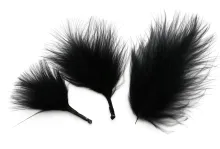
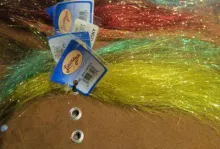

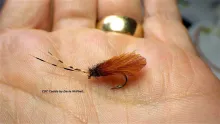
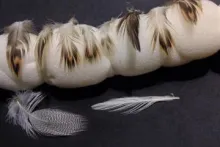
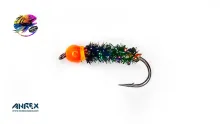
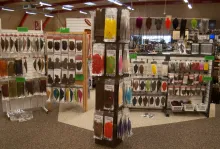

Synthetic materials
Great article and there’s certainly a wide choice of inexpensive materials available today however are these same materials adding to the micro plastics problem that does pose a very real threat to fisheries and the environment?
True enough
Leonard,
It's quite true that the synthetics we use as fly tyers and fishermen will most likely add to the vast amount of plastic and other synthetics that litter the world - including micro plastics. I'm not quite on the wagon with tying using natural materials only, but I certainly do think about the nasty footprints we set on this planet - and anglers and as consumers.
In fishing as well as in all other matters I try to recycle, make sure I treat waste properly and limit my use of plastics, but it's still very tempting to add some color and flash to a fly using some of the many materials shown here.
Martin